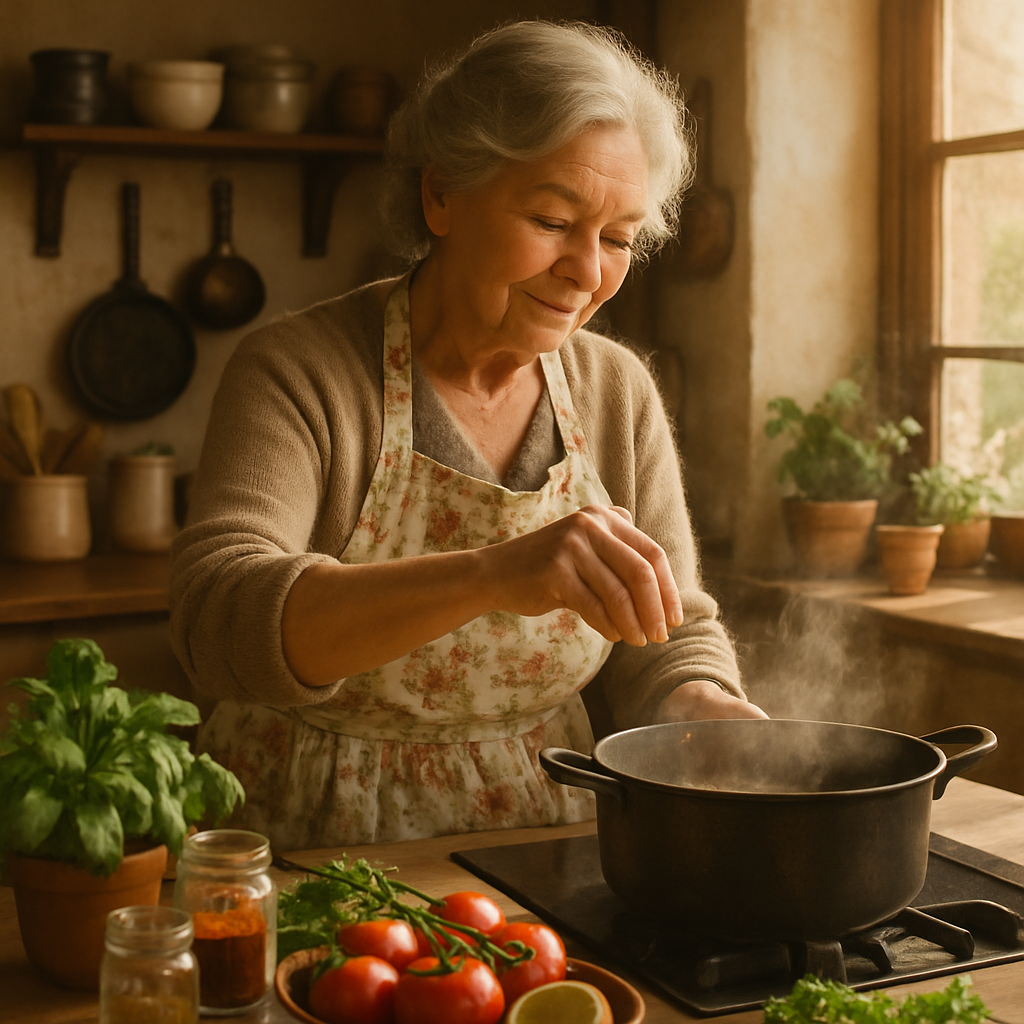The Secret Ingredients That Make Grandmas Recipes Special

There’s something almost magical about the way grandma’s cooking just hits different. Whether it’s that perfect apple pie with the flaky crust or a soup that somehow cures everything from broken hearts to actual colds, grandma’s recipes seem to contain something special that no restaurant or cookbook can quite capture. This phenomenon crosses cultures, continents, and generations – grandmothers worldwide have earned reputations as culinary wizards whose dishes create both nourishment and nostalgia.
Food scientists, chefs, and researchers have long been fascinated by what exactly makes grandma’s cooking so exceptional. Is it special ingredients? Secret techniques? Or something less tangible – like love and tradition? The truth combines practical cooking wisdom with psychological and cultural factors that transform ordinary recipes into extraordinary experiences.
The Invisible Ingredients
The most powerful components in grandma’s cooking aren’t listed on any recipe card. These intangible elements might sound sentimental, but they have real effects on both the food itself and how we perceive it.
Time ranks first among these invisible ingredients. Grandmothers typically don’t rush cooking. They allow flavors to develop slowly – whether it’s a sauce simmering for hours or dough resting overnight. This patience yields chemical reactions that modern quick-cooking methods often skip. Slow cooking breaks down tough proteins, allows fat to render properly, and gives flavors time to meld and intensify.
My neighbor’s grandmother makes a tomato sauce that cooks for nearly five hours. When I asked about this seemingly excessive time, she shrugged and said, “The tomatoes tell me when they’re ready.” This intuitive approach to cooking – listening to the food rather than the clock – results in dishes with depth that can’t be rushed.
Experience plays another crucial role. Many grandmothers have been cooking the same dishes for decades. This repetition creates muscle memory and intuition that no recipe can teach. They know exactly how dough should feel when it’s properly kneaded or when a stew has reached the perfect consistency without measuring or timing.
“I don’t measure anything,” admits Rosa, an 82-year-old Italian grandmother I interviewed. “My hands know how much flour the pasta needs today based on the humidity, the eggs, everything. Recipes are just suggestions.”
This experience-based cooking often frustrates younger generations trying to recreate beloved dishes. When asked for recipes, grandmothers might give vague instructions like “add flour until it feels right” or “cook until it smells done.” These aren’t evasive tactics but reflections of how intuitive cooking operates after years of practice.
The Physical Differences
Beyond these invisible elements, there are tangible differences in how many grandmothers approach cooking compared to modern methods.
Hand techniques represent one significant difference. Many grandmothers mix, knead, and prepare food by hand rather than using electrical appliances. This isn’t just nostalgia or resistance to technology – hand-kneading dough develops gluten differently than machine mixing. Hand-chopped vegetables create irregular pieces that provide textural variety in dishes.
Research suggests that human touch can actually affect food chemistry. The warmth of hands, the varying pressure applied, and even the microorganisms present on skin can influence fermentation processes and flavor development in certain foods.
Another key difference lies in cookware. Many grandmothers use well-seasoned cast iron pans, clay pots, or other traditional cooking vessels that have been used for decades. These develop unique properties over time. Cast iron that’s been used for generations contains layers of polymerized oils that create natural non-stick surfaces and impart subtle flavors to foods cooked in them.
A Korean grandmother I spoke with refuses to make kimchi in anything but her mother’s earthenware fermentation pot. “New containers make different kimchi,” she insists. “This pot remembers how to make it right.” While this might sound mystical, there’s science behind it – the porous clay harbors beneficial bacteria that help create consistent fermentation results.
Ingredient sourcing represents another significant difference. Many grandmothers grew up in eras when locally-grown, seasonal foods were the norm rather than a trendy choice. They often maintain relationships with local farmers, know exactly when certain ingredients are at their peak, or grow herbs and vegetables themselves.
This connection to ingredients gives them access to foods at optimal freshness and allows them to select specific varieties bred for flavor rather than shelf-life or appearance. A tomato picked ripe from a garden vine contains vastly different flavor compounds than one harvested green and ripened with ethylene gas during shipping.
Cultural Context and Memory
The cultural context surrounding grandmothers’ cooking adds another dimension to its special quality. Recipes passed through generations often connect to specific cultural traditions, celebrations, and family histories.
These dishes become more than food – they’re vessels for cultural identity and family stories. When a grandmother makes her specialty dish, she’s not just cooking food but preserving heritage. This intention often translates into extra care and attention to detail.
“When I make tamales, I’m thinking about my mother and grandmother making them together at Christmas,” explains Maria, a grandmother from Mexico. “I’m teaching my granddaughters the same way. The recipe connects us across time.”
The psychological impact of this connection can’t be overstated. Food linked to positive memories and emotions actually tastes better to us. Our brains form powerful associations between flavors, emotions, and memories that influence how we perceive taste.
Research in sensory science confirms this phenomenon. Studies show that identical foods taste different to participants when presented with different emotional contexts or memories. The nostalgia and comfort we associate with grandma’s cooking literally enhances our perception of its flavor.
This emotional connection creates a feedback loop. Because we expect grandma’s food to taste amazing, we pay more attention to the experience of eating it. We notice subtle flavors and textures we might miss when eating distractedly. Our anticipation and attention enhance our experience of the food.
Consistency also plays a role. Many grandmothers make the same special dishes repeatedly over decades, perfecting them through countless iterations. This repetition allows them to optimize recipes in ways that occasional cooks cannot. They learn exactly how long to bake something in their specific oven or how much seasoning works perfectly with their local ingredients.
This consistency creates reliable food memories. When we taste grandma’s signature dish, we’re comparing it to dozens of previous experiences with that exact same food. This familiarity breeds comfort and satisfaction that novel foods, no matter how technically perfect, cannot provide.
There’s also something to be said for cooking with love – not as a mystical force but as genuine care and attention. When someone cooks specifically to please others, they make different decisions than when cooking merely to feed. They pay closer attention to preferences, take more care with presentation, and often include special touches they know recipients will appreciate.
A grandmother might remember that you love extra cinnamon in your oatmeal or always pick out the mushrooms, and adjust her cooking accordingly. These personalized adaptations make the food feel specially created just for you – because it is.
The wisdom of grandmothers’ cooking often lies in its practicality. Many traditional recipes were developed during times of scarcity when making delicious food from humble ingredients was necessary. These recipes often employ techniques that maximize flavor from minimal ingredients – slow cooking tough cuts of meat until tender, using bones and scraps for rich stocks, or fermenting vegetables to preserve them while developing complex flavors.
Today’s home cooks can learn valuable lessons from these approaches. The recent surge in interest in fermentation, whole-animal cooking, and food preservation connects directly back to these traditional wisdom traditions that many grandmothers never abandoned.
What makes grandma’s recipes truly special isn’t any single factor but the combination of time, experience, intention, quality ingredients, and cultural context. These elements create food that nourishes both body and spirit in ways that technically perfect but emotionally neutral cooking cannot match.
We can incorporate these principles into our own cooking by slowing down, cooking with intention, developing relationships with ingredients, and connecting our food to meaningful traditions. While we can’t replicate the decades of experience or the exact context of grandmother’s cooking, we can adopt the approaches that make their food special.
The magic of grandma’s cooking reminds us that food is never just fuel. At its best, cooking is an act of connection – to ingredients, to culture, to those we feed, and to those who taught us. Perhaps that’s the most special ingredient of all.


